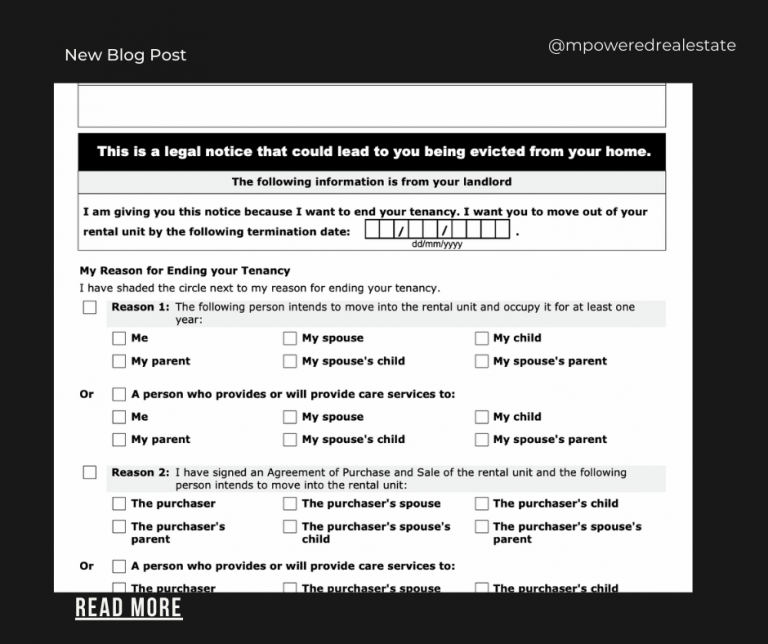Ending a tenancy in Ontario can sometimes feel complicated — but whether you’re a landlord or a tenant, there are clear rules under the Residential Tenancies Act (RTA). Following the legal process is important to avoid disputes and protect your rights.
For Tenants: Ending Your Tenancy
As a tenant, you can end your tenancy by giving your landlord proper written notice.
How to give notice:
- You must provide at least 60 days’ written notice before the end of your rental period or lease term.
- If you’re on a month-to-month tenancy, your notice must line up with the end of a rental period (e.g., the last day of the month).
- Use the official Form N9 📄 – Tenant’s Notice to End the Tenancy from the Landlord and Tenant Board (LTB). Link here: https://tribunalsontario.ca/documents/ltb/Notices%20of%20Termination%20&%20Instructions/N9.pdf
Special situations:
- If you and your landlord agree in writing, you can end the tenancy earlier.
- If you feel unsafe due to domestic violence or abuse, you may be able to give 28 days’ notice using a special form (Form N15 📄). Link here: https://tribunalsontario.ca/documents/ltb/Notices%20of%20Termination%20&%20Instructions/N15.pdf
For Landlords: Ending a Tenancy
Landlords can only end a tenancy for specific legal reasons. You cannot simply ask a tenant to leave without cause, nor can you fraudulently convince a tenant to move out then proceed to rent at a higher price (example providing a fraudulent N12).
Here are the most common legal reasons and the forms required:
- Tenant has not paid rent → Serve Form N4 – Notice to End a Tenancy Early for Non-Payment of Rent.
📄 Link here: https://tribunalsontario.ca/documents/ltb/Notices%20of%20Termination%20&%20Instructions/N4.pdf - Tenant has repeatedly paid rent late → Serve Form N8 – Notice to End Tenancy Early.
📄 Link here: https://tribunalsontario.ca/documents/ltb/Notices%20of%20Termination%20&%20Instructions/N8.pdf - Tenant has caused damage, disturbance, or illegal activity → Serve Form N5, N6, N7 depending on the situation.
📄 General form link here: https://tribunalsontario.ca/ltb/forms-filing-and-fees/#panel1 - Landlord or family member moving in → Serve Form N12 – Notice to End Tenancy (must be for landlord’s or close family’s use ONLY).
📄 Link here: https://tribunalsontario.ca/documents/ltb/Notices%20of%20Termination%20&%20Instructions/N12.pdf - Demolition, major repairs, or conversion → Serve Form N13 – Notice to End Tenancy.
📄 Link here: https://tribunalsontario.ca/documents/ltb/Notices%20of%20Termination%20&%20Instructions/N13.pdf
Important for landlords:
- You must file an application with the LTB if the tenant does not leave after the notice period.
- Only the LTB can legally order an eviction — landlords cannot change locks or remove belongings on their own.
Mutual Agreement to End a Tenancy
Sometimes, both landlord and tenant may want to end the tenancy on friendly terms. In this case, you can use: Form N11 – Agreement to End the Tenancy. This allows both parties to set an agreed-upon move-out date without going through a hearing.
📄 Link here: https://tribunalsontario.ca/documents/ltb/Other%20Forms/N11.pdf
Ending a tenancy doesn’t have to be stressful. By following the right steps, both landlords and tenants can part ways legally, fairly, and with peace of mind. Any questions, concerns or inquiries about your current rental agreement feel free to contact us, we are always here for you 🤝.
You can also check out our blog on “Common Eviction Reasons” to make sure you are always protected – https://mpoweredrealestate.ca/what-is-a-n12-common-eviction-reasons-in-ontario/






